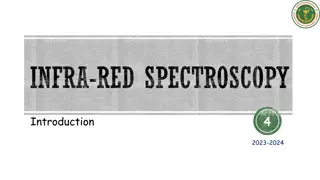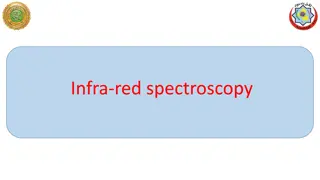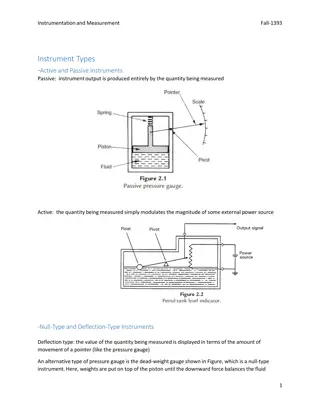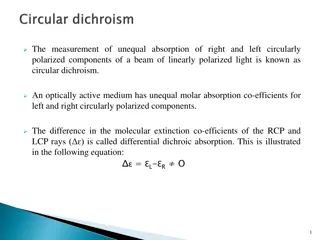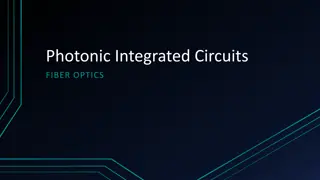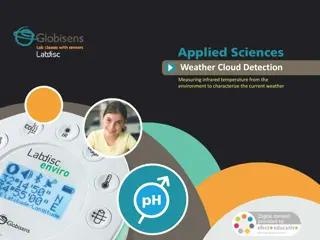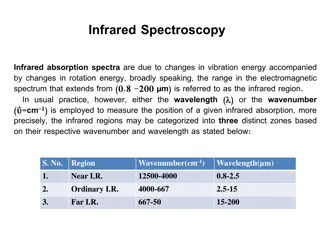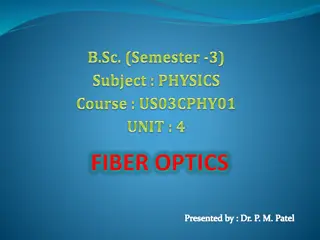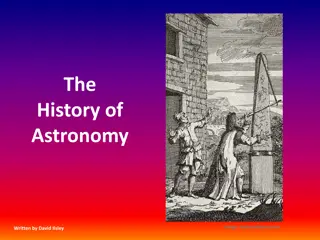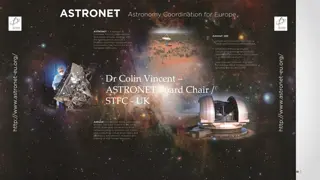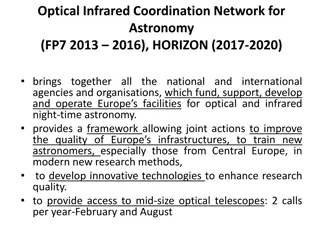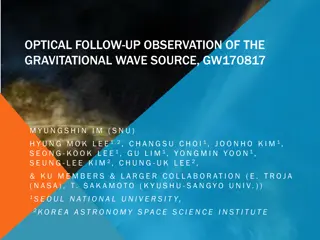Understanding Modern Optical and Infrared Astronomy Instruments
This presentation by Professor Don Figer explores modern optical and infrared instrumentation used in astronomy, including cameras, spectrographs, and specialized devices like coronagraphs. It covers instruments such as HST, Spitzer, Chandra, JWST, ELTs, and WFIRST, highlighting their capabilities in detecting and analyzing astronomical phenomena. The lecture delves into the significance of technology-led discoveries and the diverse types of instruments used in astronomical research, emphasizing their critical roles in converting light into measurable signals.
Download Presentation

Please find below an Image/Link to download the presentation.
The content on the website is provided AS IS for your information and personal use only. It may not be sold, licensed, or shared on other websites without obtaining consent from the author. Download presentation by click this link. If you encounter any issues during the download, it is possible that the publisher has removed the file from their server.
E N D
Presentation Transcript
UNIVERSITY ASTRONOMY Professor Don Figer Instruments and Detectors I 1
Aims for Lecture Introduce modern Optical/NIR/UV instrumentation (6.5-6.7) instrument requirements instrument examples Describe capabilities of commonly used instruments. HST Spitzer Chandra JWST ELTs WFIRST (Roman) 2
INSTRUMENT AND DISCOVERY 3
Instruments Astronomical instruments receive light from a telescope and convert it into measureable signals. They generally come in two forms. cameras spectrographs Some instruments have both capabilities. A third specialized form is a coronagraph (which can be followed by a camera or spectrograph). 6
Camera A camera images an object plane onto a focal plane. A detector is at the final focal plane. A camera often serves the function of changing the plate scale to match the point spread function of the image to the pixel size narrowing the light to the wavelengths of interest controlling the environment of the detectors, i.e. the temperature 7
Simple vs. Complex Camera A simple camera could consist of just a detector and a housing. For better sensitivity, the detector is cooled. To cool the detector requires a cooling system, such as a cryostat, and a vacuum vessel. 8
Camera Changing Plate Scale 1 = = = = ( ) T T T plate scale cam ( / ) ( / ) ( / ) s s F F F F F F F F cam T cam coll T T cam coll T cam coll 1 1 1 f ( , ) f plate scale = = = . cam cam ( ) f plate scale ( / ) ( / ) f D F F f D f f D T T T T cam coll T T cam coll T cam red=optics blue=rays black=focal/pupil planes green=optical axis prime focal plane final focal plane primary pupil plane collimator camera T sT scam FT Fcoll Fcam 9
Coronagraph A coronagraph is the name of an optical system that blocks the light from a point source. It allows light from nearby objects to reach the detector. The purpose is typically to block the bright light of a star in order to allow one to see the faint light of a nearby planet. Other methods include nulling interferometer and phase mask. 10
Spectrograph A spectrograph produces an image of an object at a range of wavelengths. It typically consists of a slit, collimator, grating, camera, and a detector. 11
Spectrograph Output Single Slit In a single slit spectrograph, all the light is blocked except for light corresponding to objects aligned on to the slit. The light that goes through the slit is dispersed according to wavelength and imaged onto the detector. In the example below, there is light at all locations in the slit (middle image), but the brightest corresponds to the objects at x=550 and y=300 and x=550 and y=700. 12
Spectrograph Output Multislit In a multiple slit spectrograph, small slits can be placed randomly on objects in the focal plane. The light that goes through the slits is dispersed according to wavelength and imaged onto the detector. In the example below, light from many objects goes through the slits. It is important that the spectra do not overlap. 13
INSTRUMENT REQUIREMENTS 14
Instrument Science Requirements Astronomers carefully design and build instruments to satisfy science-driven requirements. spatial resolution spectral resolution wavelength coverage sensitivity dynamic range field of view 15
Instrument System Requirements spectrograph and/or camera sampling filters exposure time cadence (short/long) stability photometric spectral 16
Instrument Engineering Requirements detector/electronics pixel size quantum efficiency noise dark current supported exposure times sampling speed optics materials irregularity/wavefront error f/number optics efficiency coatings mechanics environment pressure temperature stability 17
Instrument Constraints cost schedule volume mass power 18
INSTRUMENT COMPONENTS 19
Detectors Detectors convert light into a measureable signal. The signal is often a voltage that is proportional to the incoming light level. Charge-Coupled Devices (CCDs) are commonly used in the optical- through-x ray bands. 20
Optics 21
Electronics There are many kinds of electronics in an instrument. Detector control clock bias data acquisition readout multiplexer pre-amplifier digitizer Motion control Thermometry Computer(s) 22
Electronics: JWST SIDECAR Teledyne Cryogenic (40 K) 36 channels 1 MHz, 16-bit A/D Clocks Biases Custom microcode Flying on JWST First use on HST 24
Focal Plane Assembly The FPA contains the detector(s) and provisions for optical, mechanical, thermal, and electrical interfaces. The upper picture is of a 16 megapixel detector that was a prototype for those on JWST. The lower picture shows the detector head assembly in a 3D rendering. 25
Software data acquisition control virtual instrument quick look quick pipeline data reduction pipeline simulators 28
INSTRUMENT EXAMPLES - EXISTING 29
Hubble Space Telescope Field of View WFC3 ACS STIS COS FGS 32
HST: WFC3 33
Chandra Space Telescope ACIS: Advanced Charged Couple Imaging Spectrometer (ACIS): Ten CCD chips in 2 arrays provide imaging and spectroscopy; imaging resolution is 0.5 arcsec over the energy range 0.2 - 10 keV; sensitivity: 4x10-15 ergs/cm2/sec in 105 s HRC: High Resolution Camera (HRC): Uses large field-of-view mircro-channel plates to make X-ray images: ang. resolution < 0.5 arcsec over field-of-view 31x31 arc0min; time resolution: 16 micro-sec sensitivity: 4x10-15 ergs/cm2/sec in 105 s Spectral modes High Energy Transmission Grating (HETG): spectral resolution of 60- 1000 over energy range 0.4 - 10 keV Low Energy Transmission Grating (LETG): spectral resolution of 40- 2000 over the energy range 0.09 - 3 keV 37
INSTRUMENT EXAMPLES - JWST 41
JWST NIRCAM: near-infrared camera NIRSPEC: near-infrared spectrograph MIRI: mid-infrared imager 42
JWST: NIRCAM Nyquist-sampled imaging at 2 and 4 microns -- short wavelength sampling is 0.032"/pixel and long wavelength sampling is 0.065"/pixel 2.2'x4.4' FOV for one wavelength provided by two identical imaging modules, two wavelength regions are observable simultaneously via dichroic beam splitters. 43
JWST: NIRSPEC 1-5 um; R=100, 1000, 3000 3.4x3.4 arcminute field Uses a MEMS shutter for the slit 44
JWST: MIRI 5-27 micron, imager and medium resolution spectrograph (MRS) MIRI imager: broad and narrow-band imaging, phase-mask coronagraphy, Lyot coronagraphy, and prism low-resolution (R ~ 100) slit spectroscopy from 5 to 10 micron. MIRI will use a single 1024 x 1024 pixels Si:As sensor chip assembly. The imager will be diffraction limited at 7 microns with a pixel scale of ~0.11 arcsec and a field of view of 79 x 113 arcsec. MRS: simultaneous spectral and spatial data using four integral field units, implemented as four simultaneous fields of view, ranging from 3.7 x 3.7 arcsec to 7.7 x 7.7 arcsec with increasing wavelength, with pixel sizes ranging from 0.2 to 0.65 arcsec. The spectroscopy has a resolution of R~3000 over the 5-27 micron wavelength range. The spectrograph uses two 1024 x 1024 pixels Si:As sensor chip assemblies. 45
INSTRUMENT EXAMPLES - FUTURE 47
Extremely Large Telescopes Future ELTs include Thirty Meter Telescope (TMT) Giant Magellan Telescope (GMT) European ELT (E-ELT) Each telescope will have a suite of optical and infrared instruments, including cameras and spectrographs. There will be seeing-limited and diffraction-limited (aided by Adaptive Optics) instruments. The spectrographs will include single slit and multi-object designs. 48
Roman Observatory Roman uses an old 2.4 m spy telescope. It seeks to unravel the secrets of dark energy and dark matter, search for and image exoplanets, and explore many topics in infrared astrophysics. Instruments Wide Field Imager/Spectrometer & Integral Field Unit Internal Coronagraph with Integral Field Spectrometer It has a GEO orbit. Launch in a few years? 52



